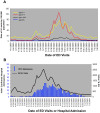The effectiveness of U.S. public health surveillance systems for situational awareness during the 2009 H1N1 pandemic: a retrospective analysis
- PMID: 22927904
- PMCID: PMC3425556
- DOI: 10.1371/journal.pone.0040984
The effectiveness of U.S. public health surveillance systems for situational awareness during the 2009 H1N1 pandemic: a retrospective analysis
Abstract
Background: The 2009 H1N1 outbreak provides an opportunity to learn about the strengths and weaknesses of current U.S. public health surveillance systems and to identify implications for measuring public health emergency preparedness.
Methodology/principal findings: We adopted a "triangulation" approach in which multiple contemporary data sources, each with different expected biases, are compared to identify time patterns that are likely to reflect biases versus those that are more likely to be indicative of actual infection rates. This approach is grounded in the understanding that surveillance data are the result of a series of decisions made by patients, health care providers, and public health professionals about seeking and providing health care and about reporting cases to health authorities. Although limited by the lack of a gold standard, this analysis suggests that children and young adults are over-represented in many pH1N1 surveillance systems, especially in the spring wave. In addition, the nearly two-month delay between the Northeast and the South in the Fall peak in some surveillance data seems to at least partially reflect regional differences in concerns about pH1N1 rather than real differences in pH1N1 infection rates.
Conclusions/significance: Although the extent of the biases suggested by this analysis cannot be known precisely, the analysis identifies underlying problems with surveillance systems--in particular their dependence on patient and provider behavior, which is influenced by a changing information environment--that could limit situational awareness in future public health emergencies. To improve situational awareness in future health emergencies, population-based surveillance systems such as telephone surveys of representative population samples and seroprevalence surveys in well-defined population cohorts are needed.
Conflict of interest statement
Figures






References
-
- World Health Organization (WHO): Pandemic (H1N1) 2009 - update 103. Available: http://www.who.int/csr/don/2010_06_04/en/index.html via the Internet. Accessed: 22 November 2011.
-
- Brammer L, Blanton L, Epperson S, Mustaquim D, Bishop A, et al. (2011) Surveillance for influenza during the 2009 influenza A (H1N1) pandemic-United States, April 2009–March 2010. Clin Infect Dis 52 (Suppl 1)S27–35. - PubMed
-
- President's Council of Advisors on Science and Technology (PCAST): Report to the President on U.S. preparation for 2009-H1N1 influenza. Available: http://www.whitehouse.gov/assets/documents/PCAST_H1N1_Report.pdf via the Internet. Accessed: 22 November 2011.
-
- Jhung MA, Swerdlow D, Olsen SJ, Jernigan D, Biggerstaff M, et al. (2011) Epidemiology of 2009 pandemic influenza A (H1N1) in the United States. Clin Infect Dis 52 (Suppl 1)S13–S26. - PubMed
-
- Swerdlow DL, Finelli L, Bridges CB (2011) 2009 H1N1 influenza pandemic: field and epidemiologic investigations in the United States at the start of the first pandemic of the 21st century. Clin Infect Dis 52 (Suppl 1)S1–S3. - PubMed
Publication types
MeSH terms
Grants and funding
LinkOut - more resources
Full Text Sources
Medical

